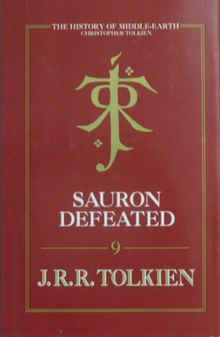The History of Middle-earth is a 12-volume series of books published between 1983 and 1996 that collect and analyse much of Tolkien's legendarium, compiled and edited by his son, Christopher Tolkien. The series shows the development over time of Tolkien's conception of Middle-earth as a fictional place with its own peoples, languages, and history, from his earliest notions of a "mythology for England" through to the development of the stories that make up The Silmarillion and The Lord of the Rings. It is not a "history of Middle-earth" in the sense of being a chronicle of events in Middle-earth written from an in-universe perspective; it is instead an out-of-universe history of Tolkien's creative process. In 2000, the twelve volumes were republished in three limited edition omnibus volumes. Non-deluxe editions of the three volumes were published in 2002.[1]
 The front cover of Volume 9 | |
| Editor | Christopher Tolkien |
|---|---|
| Author | J. R. R. Tolkien |
| Country | United Kingdom |
| Language | English |
| Genre | High fantasy |
| Publisher | George Allen & Unwin (UK) |
Publication date | 1983 to 1996 |
| Media type | Print (hardback and paperback) |
| Pages | 12 volumes |
| Preceded by | The Monsters and the Critics, and Other Essays |
| Followed by | Roverandom |
Contents edit
Some of the content consists of earlier versions of already published works, while other portions are new material. These books are extremely detailed, often analysing a scrap of paper to provide the full evolution of two or even three different versions of a passage that were rewritten over each other. Despite the great amount of material in the twelve volumes, numerous unpublished texts are still known to exist in the Bodleian and Marquette University libraries, and in other papers held by individuals or organizations, such as the Elvish Linguistic Fellowship.
The first five books track the early history of The Silmarillion and related texts. Books six to nine discuss the development of The Lord of the Rings; book nine also discusses the Númenor story in the form of The Notion Club Papers. Books ten and eleven focus on material from the Silmarillion that Tolkien worked on after The Lord of the Rings was published, including the Annals of Beleriand and the Annals of Aman. Book twelve discusses the development of the Appendices to The Lord of the Rings and examines assorted writings from the last years of Tolkien's life.
Christopher Tolkien, who edited the books, made the decision not to include any material related to The Hobbit in The History of Middle-earth. His reasons for this were that it had not been intended to form part of the mythology, was a children's story, and had originally not been set in Middle-earth; it was revised during the writing of The Lord of the Rings. The History of The Hobbit was published separately, in two volumes, in 2007 and was edited by John D. Rateliff.
Volumes edit
|
|
|
|
A combined index was published six years after the series was completed as The History of Middle-earth: Index (2002).
A shorter version of volume 9, omitting material not related to The Lord of the Rings, was published as The End of the Third Age; this is usually sold as a boxed set along with volumes 6, 7 and 8 as The History of the Lord of the Rings.
Reception edit
Charles Noad, reviewing The War of the Jewels in Mallorn, comments that the 12-volume History had done something that a putative single-volume edition of The Silmarillion (such as Tolkien had hoped to publish) with embedded commentary could not have achieved: it had changed people's perspective on Tolkien's Middle-earth writings, from being centred on The Lord of the Rings to what it had always been in Tolkien's mind: Silmarillion-centred.[2]
Reviewing The Peoples of Middle-earth, Noad adds that "The whole series of The History of Middle-earth is a tremendous achievement and makes a worthy and enduring testament to one man's creative endeavours and to another's explicatory devotion. It reveals far more about Tolkien's invented world than any of his readers in pre-Silmarillion days could ever have imagined or hoped for." He concludes that thorough study of the twelve volumes would be essential for understanding "Tolkien's imaginative art".[3]
References edit
- ^ "The History of Middle-earth". An Illustrated Tolkien Bibliography. TolkienBooks.net. 2014. Retrieved 16 July 2014.
- ^ Noad, Charles (1994). "[Untitled Review of The War of the Jewels]". Mallorn (31): 50–54. JSTOR 45320384.
- ^ Noad, Charles E. (1996). "[Untitled Review]". Mallorn (34): 33–41. JSTOR 45321696.
Further reading edit
- Bratman, David (2000). "The Literary Value of 'The History of Middle-earth'". Contributions to the Study of Science Fiction and Fantasy (86): 69–94.
- Whittingham, Elizabeth A. (2017). The Evolution of Tolkien's Mythology: A Study of the History of Middle-earth. McFarland. ISBN 978-1-4766-1174-7.